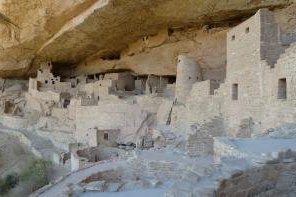
There are some sites that I want to visit from the first time I see a picture of them. The Cliff Palace at Mesa Verde has been one of them for several years, and it certainly didn't disappoint.
The tour of the Cliff Palace was really well conducted. Our guide was very informative and friendly evidently reflecting a love of his job. The first view of the "Palace" from the lookout was impressive, but getting down in amongst the ruins was the real highlight. The precarious location has meant that this magnificent feat of engineering has remained in very good condition, with only a few minor modern enhancements. It is incredible to think how these structures were built in this location. Our guide provided answers and various points of view relating to how and why they were created, personally I like this "post-modern" approach to presenting conflicting ideas and answers rather than relying on a basic catch-all narrative. The tour wasn't too physically challenging either.
After the tour we drove off on the Mesa Top loop, this afforded great views of the canyon containing the Cliff Palace, as well as nearly a dozen other clusters of houses tucked under the rim. Another good thing about this drive was that there were remains from earlier structures, showing how settlements progressed from the basic round houses on the Mesa top, through to pueblo like structures and then eventually over the edge to the cliff dwellings. On the way out we had a …
Keep reading 0 comments
Heavily promoted as one of the new seven natural wonders of the world, Jeju Island, an oval volcanic island in the East China Sea, is a different country of South Korea with its different landscape, climate, architecture or even the taste of kimchi. Jeju is not a new discovered destination for me; my Korean friend often posted their honeymoon photos on Jeju on their webpage, Jeju is popular for Korean honeymooner, and during my last trip to Seoul, I saw many advertisements of its new seven wonder campaigns, even a large booth in Seoul Station for clicking the vote, so when I decided to visit Korea again, part of my annual Asian trip this year, I requested to visit Jeju as my prime destination to discover this island.
The best way to see Jeju is to rent a car, after landed at Jeju Airport, my first place to visit was the famous Manjanggul Cave; the lava tube cave is indeed a great site, very interesting, unique and definitely the best site of Jeju. While I really enjoyed the place, I also really concerned with the protection of the cave, currently tourists can freely touch and walk inside which finally someday will damage the cave and its unique lava surface. My next destination was the famous sunrise peak or Seongsan Ilchulbong which is actually an eroded volcano next to the sea; I was surprised to discover that the peak is surrounded by a very big town and large car …
Keep reading 0 comments
As of Jan. 2012 the Cultural Triangle Pass which cost $50.00 U.S. and was good for The World Heritage Sites was discontinued leaving the individual sites on per site ticket basis. Sigiriya admission is $30.00 If you chose to leave by the admission gate for rest spell at the air conditioned museum they will not let you re-enter. The ticket says good for one day but only if you make it good. All the food and beverage stalls are located at the parking area so if your going to spend all day here and want food do not exit the admission gate. Sigiriya is an interesting site although its mostly just ruins around and on top of a hugh rock. Giant lion's claws greet the visitor half way up. The awesome head of this lion grand strairway entrance now is long gone. Before you get to this site you are funneled past the well preserved wall paintings of buxom maidens still in full color. This is a sight to see considering their skillful handling and preservation. People who are afraid of heights may not be crazy about going to the top. The steel constructed stairway in the rock is safe enough and well maintained and the views from the top are worth the effort. Wild elephants sometimes frequent the circle road area around the rock and Languar monkeys also live in the forest around the rock.
Keep reading 0 comments
NOT OPEN TO THE PUBLIC!
I have attempted to visit this site several times only to be told that it was closed to the public and would "reopen" at a later date. This last attempt was on 27 October 12. I took a bus from Mexico City and had the driver drop me off in San Felipe Sultepec and walked to Tecoaque. I did get there early enough (before the caretakers) and did get to walk around a little as there is no fence surrounding the site OR signage indicating that it is indeed closed to the public until I was "escorted" off the property by an INAH employee. Even INAH's website indicates that "TECOAQUE" is open daily, with no admission fee.
The Texcoco-Calpulalpan road is currently being widened so that the east bound lanes are literally right next Tecoaque and will most likely ruin this site forever. The noise from the traffic is already deafening and the pollution will be a major factor.
Another problem is that there are new highway signs all over the area directing you to Tecoaque, but NOT indicating that it is closed and looks to remain that way for a long time. I visited the site "Los Cerritos" just out outside of Culpulalpan on the 24 of October and the manager (who also works for INAH) told me in fact that Tecoaque was open, yet I was turned away by another INAH employee at Tecoaque just a few days later...sorry to report such disheartening …
Keep reading 0 comments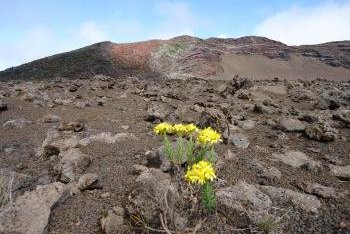
Non argueably one of world's wonders. Tropical forests, cirques, volcano, steep mountains, canyoons, watarfalls, everything can be found there.
Reunion National Park covers relatively big area almost entire interior (except those around villages), easy accesible by foot (marked trails) or bus. For those with limited time the best starting point to see the cirques is either Cilaos or Salazie (both accessible by bus).
For visiting the volcano (Piton de la Fournaise) it is better to have your own / rent car good road from Bourg-Murat up to Pas de Bellecombe (free parking). Otherwise it is a half day walk up to Gite de volcano. Piton de la Fournaise resembles Teide of Tenerife but at least the crater area is much, much bigger.
Keep reading 0 comments
Officially the peak can be visited within an organised tour (trek) through the recognised guide Yan de Maroussem of Yanature. He is the only person that has permition from land owners (the most of inscribed area is private property) to do trek to almost the top of the mountain. Almost means that you can get only to so called "V" place - some 50 meters from the top. Even up to that point the trip is quite demanding (good shoes and mountain experience required).
Views from the top are really exceptional - especially those of Black River National Park. Recent price (October 2012) for 4 hours trek (usually starts at 7 a.m.) was around 40 Euro. You will feel every single euro while climbing the mountain.
Keep reading 0 comments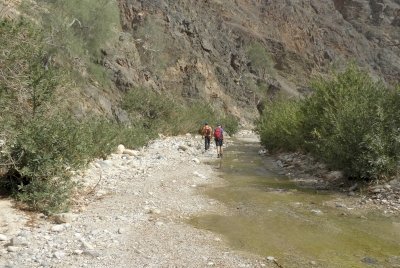
It has become a good tradition to go out into nature for a few days on every trip. In Jordan, I chose the Dana Nature Reserve for that purpose. I stayed for 2 nights in the Feynan Ecolodge, the flagship accommodation of Jordan's Royal Society for the Conservation of Nature in Dana Reserve. It is reached by 4WD only, so a local Bedouin driver will come and pick you up from the main road. That 20 minute approach alone is worthwhile for its view on the rock formations, especially in the late afternoon light.
The lodge runs entirely on solar energy, which means that there is only limited electricity at night. The lodge also provides employment opportunities by hiring jeep drivers and guides locally, and candles and bread are also made on site. 75 local families benefit from its business.
On the morning after my arrival, I joined a half day hike organized by the lodge. Together with a Belgian couple I walked to and through the Wadi Ghwayr. Our guide Ali hailed from the local village, Feynan. He first showed us the village: the summer and winter camps of the Bedouins, the mosque and the school. He himself lived in a house nowadays, but his mother who we also met still lived in the traditional way.
In the village center there are two large open spaces, one of which is a large football field, made of sand and slightly sloping. The other area is used for …
Keep reading 0 comments
I visited this part of Cairo during my time in the US Army. It was 1998 and my fourth deployment to the Middle East. Cairo was almost overwhelming in its variety of impressions, sights, and just the sheer number of people. New Mexico, where I live, has roughly 10 people per square mile, or some other ridiculously low number. Cairo has about 170,000 (based on the figures I read). WHAT A DIFFERENCE!
Having said that, the historic section of Cairo is just beautiful, even though it is showing the wear and tear of the ages. Minarets, markets, mosques, tilework, colors, smells, people...I still get dizzy thinking about it.
I only wish I had done more research prior to my visit. It sometimes becomes a little difficult to determine the age of a building...which might cause you to miss something truly remarkable.
I can only say "GO!" if the opportunity comes your way.
Keep reading 0 comments
I had to good fortune to travel to this part of Oman during my time in the US Army. It was the spring of 1997. After spending a month at the NCO Academy at Fort Campbell, Kentucky (the best three days of training ever crammed into one month) in the late winter (the ultimate definition of bleak and damp), the balmy coastal weather and dry mountain air of our camp were much needed.
Our deployment kept us too busy to visit the sites listed here. The closest we came to something like those described in the other reviews was a 14th century mosque being excavated on the outskirts of Salahlah by a German team of archaeologists. They graciously gave us a tour of the site which was very interesting, especially in terms of the burned roof timbers. The site was near the beach, but that is about all I can recall.
Lovely landscape, warm temperatures in the spring, great people, and wonderful drives in the mountains. We had a great airborne operation on the beach and I even got to meet the Crown Prince, now King, of Jordan. Go to Oman and enjoy. I wish I could...
Keep reading 0 comments
The last time I visited the gatehouse was in the late winter of 1982 with my father. We were coming back from a joint guitar lesson with the guitarist Dieter Henze in Darmstadt. It was late and cold, but we were both game for a quick stroll around the grounds at around 22:30.
We had developed a taste for this sort of activity after walking from the US Army housing in Worms, down to the cathedral, during a gentle yet steady snowfall on Christmas Eve, 1981. There is something about early-medieval architecture and dark winter nights that just goes together.
We had previously visited the site in 1977, when my mother (a native of Bad Kreuznach, Germany) recommended we go there after reading about it in her copy of "Schatzkammer Deutschlands". This is a great resource for the tourist of history in Germany as it gives highly detailed entries on the smallest to greatest historical sites in the country. It can make a drive that much more worthwhile, especially in a country as stuffed with "treasures" as Germany.
I always liked the site from our very first visit. It is small, manageable, easy to grasp, and deceptively simple. There is far more to see and learn than the size of the site might lead one to believe. And if you are there when very few (or no) people, it is especially wonderful.
I guess I retain such fond memories of Lorsch and the Torhaus because of its associations with my …
Keep reading 0 comments
Chaco Canyon (CC) is one of those sites that could take a life-time of research, interviews, reading, and visiting to even begin to comprehend. Learning just a bit will remind you of how little you knew about this WHS previous to that.
Engage in lots of reading and studying prior to a visit. Find someone who knows something about the area and pick their brains beforehand. There is so much to see, but you have to know what to look for and where it is located.
To that end, go to the Visitor Center and get a back-country hiking pass. The car loop does not really let you see what is there. Get a good park map, and hike (where it is legal to do so, of course).
I also highly recommend the book "Anasazi" by Frank McNitt. It is in print through University of New Mexico Press. It is the biography of Richard Wetherill. Opinion is extremely divided as to his legacy, as most anything to do with Southwestern archaeology usually is. However, I think the professionals' dim view of his work stems mainly from jealousy. Wetherill tended to get their first because he was willing to take the risks. The academics back East waited for him to do the locating...that's my interpretation at least.
Take plenty of water and food. There is not a whole lot out there. European visitors need to be especially aware of this. This is not like hiking in the Cotswolds, or from one …
Keep reading 0 comments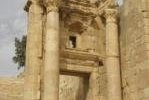
After Petra, Jerash must be the next most popular tourist destination in Jordan. I visited it on a day trip from Madaba, using my rental car to navigate through the busy and seemingly neverending suburbs of Amman.
It's a bit of a mystery why the former Roman city of Jerash (Gerasa) has been left out of the World Heritage List in the early stages. It surely is one of the most complete remains of a Roman (colonial) city that I have seen. And believe me - I have seen many!
Features that stand out here are the oval Forum, the 800m long and very intact (Pompeii-like) Cardo Maximus, and the lovely intimate North Theatre. Hundreds of pillars adorn the Forum, the streets and the temples . They have been put upright during the restorations I guess, and sometimes even pieced together again. The quality and completeness of the constructions and objects is so high that it is sometimes too good to be true. Especially both theatres have been restored almost completely to perfection - I would not be amazed that ICOMOS had something to say about that.
It's a very fine site to visit for a couple of hours, and it would be a worthy WHS. Entrance costs 8 JD (8,80 EUR). The site receives lots of visitors each day, including tour groups from all over the world.
Keep reading 0 comments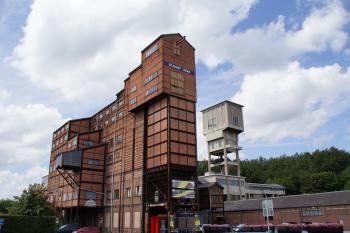
We visited the Blegny coal mine on a day trip from Aachen. Blegny is a small village near the Belgian-German border, about 10 km from Liège and 30 km from Aachen. At its closure in 1980, the Blegny mine was the oldest and last operating mine in the region. Preserved are the headframe and the coal washing plant from the 20th Century, the building and pithead of the older Marie mine, and underground shafts and galleries. Blegny is the only of the four parts of the WHS, where an underground tour is available. The tour starts with a short film about the history of the Blegny mine and the mining region. Then, equipped with a helmet and a miners coat, we took the original elevator to a level 30 metres below ground. Actually, the elevator is a two-story cage, small and narrow, thus you should not suffer from claustrophobia.
Regular tours are only in French and Dutch, but there are audioguides in English and German. The guided tour provides information on the history of mining, from the tough working conditions 200 years ago to the automated production methods in the late 20th Century. Our guide was a former miner, he had a lot to tell, his explanations were always much longer and seemed to be more amusing than the text on my audioguide. Unfortunately, my French is not good enough to understand all his anecdotes and jokes. We walked along the mining gallery and went down to a level of …
Keep reading 0 comments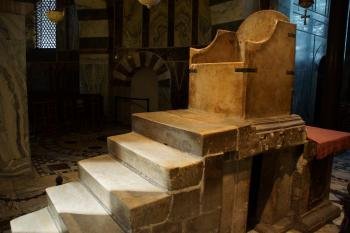
The Aachen Cathedral was among the first twelve entries in the WH list in 1978 and was the first German WHS. This is justified because of the historical and architectural significance.
Charlemagne wanted to create a Christian empire north of the Alps in succession of the Roman Empire. He built his palace in Aachen, at the place where today the City Hall is. His Palatine Chapel, the famous octagon, is the core of the Aachen Cathedral. It is considered the oldest (and for a long time the largest) vaulted building north of the Alps. But the Carolingian structure is not visible from the outside, it is covered by a striking Baroque dome (that reminds of a lemon squeezer) and surrounded by a ring of Gothic chapels. The Gothic choir hall, the Baroque dome and the tower of the westwork dominate the unusual outer appearance of the cathedral. However, I liked that mixture of architectural styles, certainly there is no cathedral with a similar shape.
The interior of the octagon is stunning: the massive columns, the high arches of the upper gallery, the huge copper chandelier. And also the mosaics of the dome and in the aisle harmonize with the whole ensemble, though they are relatively new. They were made in the late 19th Century based on medieval motifs. But also parts of the Carolingian artwork have been preserved: the ancient marble columns in the arches of the upper gallery (some of them are in the Louvre), the bronze gratings, and …
Keep reading 0 comments
The Walled City of Baku was the other WHS in Azerbeidzjan we visited, including Shrivanshah's Palace and the Maiden Tower. Pity, the restauration activities made the tower almost invisible.
Keep reading 0 comments
Just back from our trip to Azerbeidzjan and Georgia (end of sept.2012).The Rock Art in Gobustan National Park is widely spread over a huge area. Valcamonica and Tanum are more impressive, but the new museum is fantastic.
Keep reading 0 comments
After visiting Azerbeidzjan, we continued our trip to Georgia. Wonderful Mtskheta and in Kutaisi: Bagrati Cathedral and Gelati Monastery. The construction inside Bagrati Cathedral to restore the building is perfect, but outside, left from the entrance it is awful
Keep reading 0 comments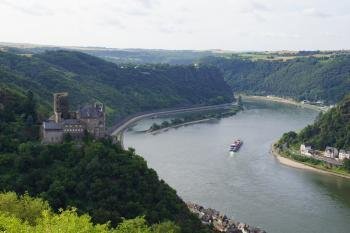
The Upper Middle Rhine Valley is an outstanding example of a European cultural landscape. The World Heritage Site comprises the 65 km long section between Koblenz and Bingen / Rüdesheim and the surrounding hills of the „Rheinisches Schiefergebirge“ (Rhenish Slate Mountains). The unique appearance of the landscape resulted from both, the natural course of the river and the human activities. During the last two millenniums, this section of the river was an important trade route, a border, the place of exchange between cultures, and battlefield in several wars.
Undoubtedly, a boat cruise is the best way to visit the Upper Middle Rhine Valley. On a hot summer day in August 2012 we started at 9 am in Rüdesheim with the first boat tour. The trip to Koblenz takes four hours, the return by train takes one hour. The boat ride is also available in the reverse direction, but upriver it takes two hours more. Sitting on the upper deck, we enjoyed the view to the steep vineyards, the castles, and the picturesque villages that lie on the narrow strip of the shore. Almost on every hill and cliff, there is a castle or ruin. We have not counted them, but according to our guide book, there are more than 40 of them.
The castles were built between the 12th and 14th Century, but most of them were destroyed in the following centuries, during the Thirty Years' War and the War of the Palatine Succession. Many castles were rebuilt in the …
Keep reading 0 comments
Idanre hills.... What a wonderful work of nature! Though getting to its top is so strenous., but its memories is what you'ld love to live with for the rest of your life..... Really wish there could be a lift to take one up cos its gona give so many people the courage to go there.... Would love to have a revisit if I have the opportunity to.., cos it's really a place worth sighting.!!!
Keep reading 0 comments
Like everybody else, I visited Quseir Amra as part of a (half) day trip to the desert castles. In my small rental car, I sped on Highway 40, one of the few roads in Jordan where it is allowed to drive 100km/h. Most of the other traffic consisted of trucks, on their way to either Iraq or Saudi Arabia. This far northeastern part of Jordan is in the border zone with both countries.
After having warmed up at the already quite pleasant Qasr al-Kharanna, I arrived at the 3 vaults of Quseir Amra. The site is outfitted with a large parking lot, a small visitor center, and a Bedouin tent where you can buy drinks and souvenirs. Entrance costs 1 JD, but the ticket is shared with the al-Kharanna and Azraq castles so I did not have to pay again. I surely wasn't the only one visiting these castles. I caught up with an English tour group here, after I was already shocked by finding 3 tour buses in the parking lot of Qasr al-Kharanna.
What remains of Quseir Amra is a rather small building, which held a bathhouse and an audience hall. Next to it stands the well that was responsible for this being a popular caravan stop during its days. The restoration of the exterior seems to have finished, but they're still working on the wall paintings inside. The large wall to the right after entering was obstructed unfortunately by scaffolding. Two Spanish women were busy …
Keep reading 0 comments